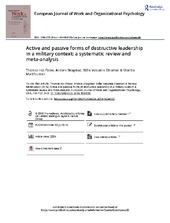| dc.contributor.author | Fosse, Thomas Hol | |
| dc.contributor.author | Skogstad, Anders | |
| dc.contributor.author | Einarsen, Ståle | |
| dc.contributor.author | Martinussen, Monica | |
| dc.date.accessioned | 2020-08-13T13:28:40Z | |
| dc.date.available | 2020-08-13T13:28:40Z | |
| dc.date.issued | 2019 | |
| dc.Published | Fosse TH, Skogstad A, Einarsen S, Martinussen M. Active and passive forms of destructive leadership in a military context: a systematic review and meta-analysis. European Journal of Work and Organizational Psychology. 2019;28(5):708-722 | eng |
| dc.identifier.issn | 1359-432X | |
| dc.identifier.issn | 1464-0643 | |
| dc.identifier.uri | https://hdl.handle.net/1956/23754 | |
| dc.description.abstract | Since the turn of the millennium, a growing academic interest has emerged regarding the dark side of leadership, both in general and specific contexts. Characteristics of military organisations may either reduce or exaggerate the prevalence and impact of destructive leadership. It is therefore pertinent to explore antecedents and outcomes of destructive leadership in the military context as compared to other settings. Here, we systematically reviewed the current literature and performed a meta-analysis of destructive forms of leadership in a military context. The reviewed studies (K = 27) primarily employed context-free instruments, applied cross-sectional designs, and examined outcomes of destructive leadership. Both active (e.g., abusive supervision) and passive (e.g., laissez-faire) forms of destructive leadership were examined in the meta-analysis (K = 22, N = 10,716). The mean correlation to performance, attitude, health, and well-being was −.29 for active destructive leadership, −.29 for passive forms of destructive leadership and, in comparison, .32 for constructive and effective forms of leadership. Our findings demonstrate that passive and active forms of destructive leadership in a military context may contribute equally to detrimental outcomes, and that successful strategies to prevent and handle consequences of destructive leadership must address both forms of unwanted leadership behaviour. | en_US |
| dc.language.iso | eng | eng |
| dc.publisher | Taylor & Francis | eng |
| dc.relation.uri | https://www.tandfonline.com/doi/full/10.1080/1359432X.2019.1634550 | |
| dc.rights | Attribution-Non Commercial-No Derivatives CC BY-NC-ND | eng |
| dc.rights.uri | http://creativecommons.org/licenses/by-nc-nd/4.0/ | eng |
| dc.title | Active and passive forms of destructive leadership in a military context: a systematic review and meta-analysis | eng |
| dc.type | Peer reviewed | |
| dc.type | Journal article | |
| dc.date.updated | 2019-12-13T12:56:22Z | |
| dc.description.version | publishedVersion | |
| dc.rights.holder | Copyright 2019 The Authors | eng |
| dc.identifier.doi | https://doi.org/10.1080/1359432x.2019.1634550 | |
| dc.identifier.cristin | 1709684 | |
| dc.source.journal | European Journal of Work and Organizational Psychology | |

